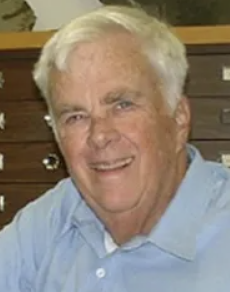
ASU remembers
Carleton Bryant Moore
School of Molecular Sciences & School of Earth & Space Exploration - 1961-2003

February 10, 2023
|
Dr. Carleton Bryant Moore attended Alfred University in Alfred, New York where he studied ceramic engineering and received a B.S. degree in Glass Technology from the New York State College of Ceramics. Shortly after, Carleton started work at Brookhaven National Laboratory with Oliver Schaeffer and Nobel Laureate Raymond Davis in the summer of 1955 on a project using cosmic ray exposure to determine rock ages before beginning his graduate studies at the California Institute of Technology in Pasadena, California. At Caltech, Carleton's graduate studies were primarily in chemistry but also included a minor in geology under the direction of thesis advisor Harrison Brown where he first studied meteorite chemistry. He completed his PhD in Chemistry in 1960. Professor Moore's first position was at Wesleyan University in Middleton, Connecticut where he taught from 1960 to 1961. He was contacted by Arizona State University in 1961 to become the founding director of ASU's Center for Meteorite Studies in the Department of Chemistry. ASU had just acquired the large meteorite collection from Harvey Nininger and Carleton was put in charge of expanding the collection and conducting research on its unique extraterrestrial samples. Professor Carleton Bryant Moore was a pioneering researcher in the field of meteorite studies, and the founding Director of the ASU Center for Meteorite Studies, which houses the world's largest university-based meteorite collection. He helped train the NASA Apollo astronauts that were candidates for missions to the Moon on what type of samples to collect while on the moon. He was credited with being the first scientist to detect the different types of carbon in the returned lunar samples. Professor Moore and his team measured the carbon contents of the returned Apollo 12, 14, 15, 16 and 17 samples in the Lunar Receiving Laboratory in Houston. He was also one of the researchers who identified the first extraterrestrial amino acids in freshly fallen meteorites. For his contribution to meteorite research, the International Astronomical Union named an asteroid, 5046 Carletonmoore in his honor. In addition, a mineral, carletonmooreite was named for him in 2021. Moore authored 160 publications on meteorite research and a frequently cited article on removal of Arsenic from water. He also held a patent for an artificial desert varnish that helped mend vandalism to petroglyphs and excavation scars along highways. From 1963 to 1987, Moore acquired thirty-five research grants from NASA, The National Science Foundation (NSF), and the United States Geological Survey (USGS) related to the study of asteroids, lunar samples, geology, and materials science. Moore's work provided the foundation for the continued development of the Center for Meteorite Studies as well as the growth of astrophysics and planetary geology at ASU. Moore spent considerable time at NASA's Johnson Space Center performing carbon analysis on the returned lunar samples and assisting with the development of the lunar and meteorite educational disk project in which lunar and meteorite samples are available for study by students in classrooms throughout the world. In 1969, Moore became editor of the journal Meteoritics, a position he held for twenty years as a member, fellow and president of the Meteoritical Society. In 1984, during Moore's leadership, Meteoritics won the Citation Index Impact Award. Professor Moore taught thousands of undergraduates in chemistry and geology during his 44year career at ASU, and was also particularly proud of having served as the thesis advisor to 36 MS and PhD graduate students during his tenure. In 2003, he retired from ASU and became a member of ASU's Emeritus College. He had served as the Director for the Center for Meteorite Studies for 42 years, continuously holding the same administrative position his entire career. Under his leadership, the Center for Meteorite Studies increased its meteorite holdings from 578 specimens to over 1700 samples, creating a valuable resource for researchers and students, at ASU and around the world. Carleton was also passionate about supporting environmental causes including Boyce Thompson Arboretum, Arizona and Vermont chapters of The Nature Conservancy, and Audubon Arizona. He had recently received his 50-year membership certificate from the Sierra Club. He especially enjoyed spending summers in Estes Park, Colorado with his family, exploring 'every single boulder and rock' in Rocky Mountain National Park. In addition, he liked sharing his interest in meteorites with local elementary school students and would randomly surprise children by gifting them tiny meteorites as they walked past. Carleton is survived by his two children, two grandchildren, as well as his sister. He is also survived by his wife Diane Rhodes Moore, two stepchildren, and two granddaughters. |